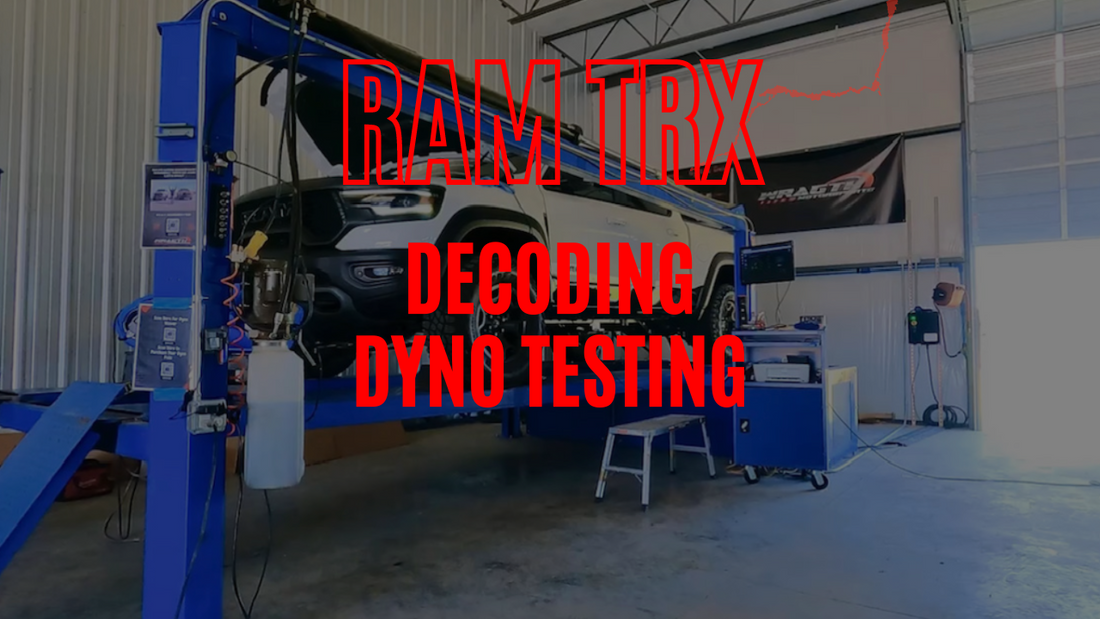
Decoding Dyno Testing: Unraveling the Differences Between Mustang Dyno, Dyno Jet, and Hub Dyno for Ram TRX Horsepower Numbers
Share

One common topic of discussion among Ram TRX enthusiasts is dyno testing and numbers. Dyno testing is a popular method to measure a vehicle's horsepower and torque output, and it can provide valuable insights into a vehicle's performance. However, not all dyno testing methods are created equal, and there are key differences between the three most common types of dynos used: Mustang Dyno, Dyno Jet, and Hub Dyno. In this blog post, we will explore these differences and how they can impact horsepower readings, particularly in the context of the Ram TRX, a high-performance pickup truck.
Load Control:
One of the key differences between Mustang Dyno and Dyno Jet is how they control the load during testing. Both are types of chassis dynos that used to provide load control, simulating road resistance. However, Dyno Jet uses a power absorber system, while Mustang Dyno uses an eddy current brake. The load control on Mustang Dyno is known for its fine-tuning capability and ability to simulate real-world driving conditions, whereas Dyno Jet may have less precise load replication. This can result in slightly higher readings on Dyno Jet. Additionally, Dyno Jet typically applies a correction factor for environmental conditions, while Mustang Dyno typically does not. This is why some refer to the Mustang Dyno as the “heartbreaker”. It's important to consider these differences in load control, calibration, and correction factors when interpreting horsepower readings from different dyno types.
Test Conditions:
Another crucial factor to consider when comparing dyno types is the test conditions they can replicate. Mustang Dyno and Dyno Jet are both capable of simulating various road conditions, such as different speeds, gear shifts, and throttle inputs. They can also perform steady-state tests or simulate real-world driving conditions. However, the accuracy of the results may depend on the calibration and setup of the specific dyno.
Hub Dyno, on the other hand, does not replicate road conditions as it measures power output directly from the hubs. It does not simulate vehicle movement or gear shifts, and the results may not fully reflect the vehicle's performance in real-world driving conditions. Hub Dyno is typically used for specific testing purposes, such as tuning or verifying powertrain components in a controlled environment.
Horsepower Readings:
The differences in load control and test conditions can also impact the horsepower readings provided by each dyno type. Mustang Dyno and Dyno Jet are known for providing "heartbreaker" or "conservative" horsepower readings, as the load control and test conditions are designed to provide realistic and accurate measurements that may be lower than other dyno types. This is because these dynos aim to replicate real-world driving conditions more closely, taking into account factors such as drivetrain losses and environmental variables.
On the other hand, Hub Dyno typically provides "higher" horsepower readings as it measures power output directly from the hubs without accounting for factors such as tire slippage or drivetrain losses. Hub Dyno readings are often referred to as "flywheel" horsepower, as they do not take into account losses incurred in the drivetrain.
Conclusion:
In conclusion, when comparing Mustang Dyno, Dyno Jet, and Hub Dyno for horsepower measurements on the Ram TRX or any other vehicle, it's essential to understand the differences in load control, test conditions, and horsepower readings. Mustang Dyno provides more realistic and conservative horsepower readings, while Hub Dyno may provide higher readings The choice of dyno type depends on the specific testing requirements and the desired level of accuracy. This is why instead of focusing on numbers, we should focus on gains over baseline which will remain constant among different types of dyno’s.